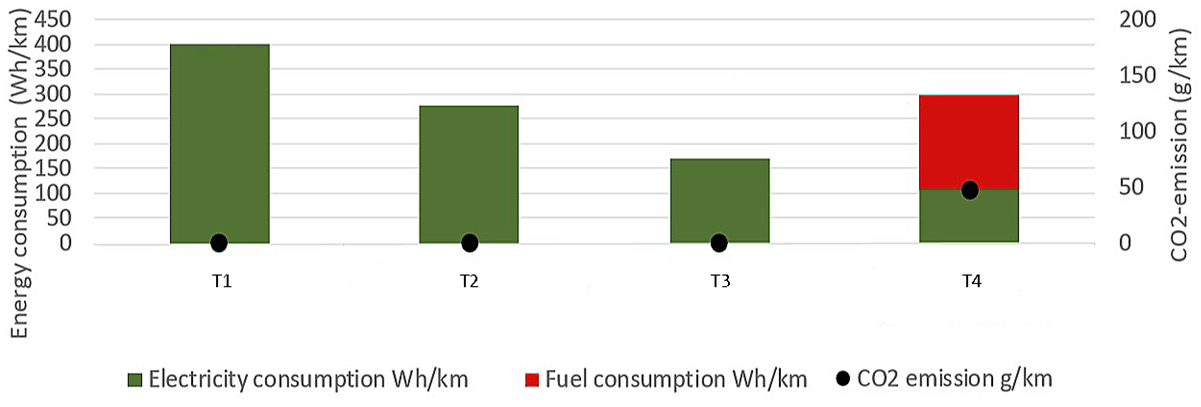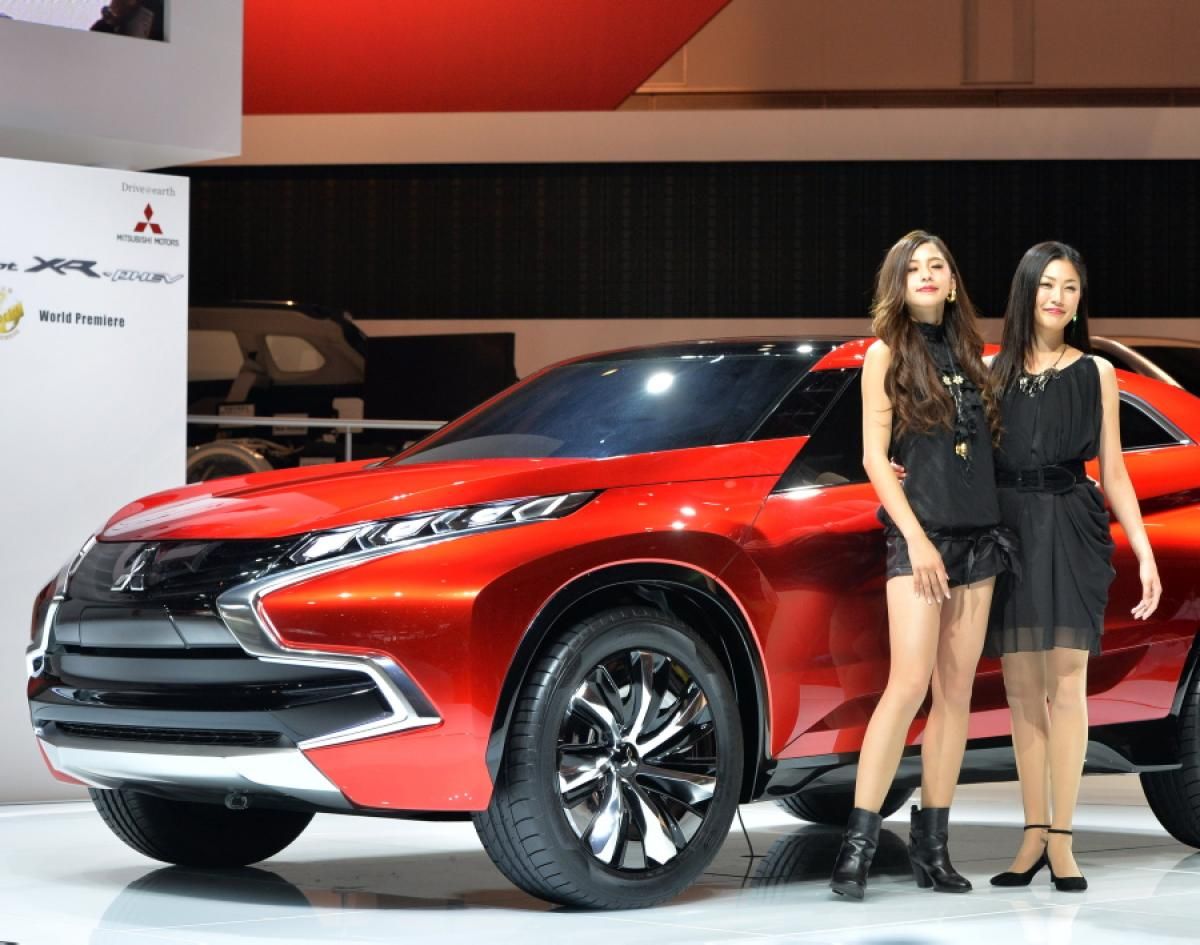PHEV test in Bucuresti
Nicolae Icpe, Bucuresti, Romania
Abstract
The paper presents the analysis of two passenger cars with plug-in hybrid technology on daily use in the city of Bucuresti. Cars have been tested according to several parameters under different conditions of traffic, driving style and ambient temperature. The results were then compared.
Keywords: plug-in hybrid, electric vehicles, electro mobility
Received: 09 11 2019
1. Introduction
The transition from ICE vehicles to pure electric vehicles will be done with an intermediary stage that consists of vehicles with plug-in hybrid technology. PHEV’s are the most suitable passenger cars that can make the transition to full electric vehicles. PHEV’s can be driven with zero emissions in the city but also can travel long distances in areas where the charging infrastructure is not sufficiently developed.
The plug-in hybrid electric vehicles use both a battery that powers an electric motor and an internal combustion engine (ICE).
PHEV’s can utilize grid electricity charged into the vehicle’s battery for propulsion in full electric mode up to 20-80 km of range depending on the battery capacity and vehicle’s configuration. For longer distances and when the power in the electrical system is insufficient or there is no charging infrastructure, the on-board ICE supports propulsion.
The duality of power sources and engines/motors in the PHEV’s introduce flexibility for the consumer, and the driver can select different dive modes where the ICE is operating to a larger or lesser extent. The real traffic propulsion system usage patterns can there be much more diversified for these PHEV’s than for a classic ICEVs.
Extra components, charger and lager batteries offer extra weight to a PHEV compared to a HEV and this may lead to high environmental impact by higher emissions. The key rests on the share of driving that can be and is accomplished in the pure electric drive mode.
The usage profile of the PHEV owner will influence emissions. If the owner got the possibility to charge frequently or infrequently or drive short or long distances.
Thus, the PHEV is more expensive to buy than a HEV, Romanian government grants incentives for users who wants to buy a new PHEV. The amount granted is 5 000 Euro and is available in Rabla Plus Scrappage Program.
2. Survey
Two PHEV’s were tested extensively in the capital city’s traffic and surroundings. Especially sub-urban areas of Mogosoaia, Poesti-Leordeni and Otopeni.
Vehicle A was a compact sized vehicle which, according to the catalogue, has an E-mode range of 50 km, emit 37 g CO 2 /km with an average energy consumption of 117 Wh/km of electricity and 1.6 litre of petrol/100 km. Vehicle B was a mid-sized plug-in hybrid vehicle, which according to the catalogue, has an E-mode range of 31km, emit 48 g CO 2 /km with an average energy consumption of 110 Wh/km of electricity and 2.1 litre of petrol/100 km.
These two vehicles were tested in different combinations of input conditions like type of urban and sub-urban traffic, ambient temperature from +20 o C to -5 o C, cold or warm starts, fully charged and fully discharged batteries and in different user selectable driving modes.
Similar routes have been chosen daily for both vehicles. One in the morning from the sub-urban area to the city centre and one in the evening around the city centre. Both vehicles were charged at the same stations and driven by the same drivers in the morning and also in the evening.
The main technical characteristics of the two PHEVs tested are presented in table 2.1.
| Vehicle 1 | Vehicle 2 | |
| E-mode range | 50 km | 31 km |
| CO2 emissions | 37 g/km | 48 g/km |
| NO2 emissions | 8.9 mg/km | 9 mg/km |
| Fuel consumption | 1.6 litre/100 km | 2.1 litre/100 km |
| Calculated fuel energy | 14,5 kWh/100 km | 18,8 kWh/100 km |
| Electricity consumption | 11,4 kWh/100 km | 11,0 kWh/100 km |
| Battery capacity | 8,7 kWh | 6,4 kWh |
| Charging time 3.6 kW | 2 h 15 min | 1 h 45 min |
| Acceleration 0-100 km/h | 7,6 sec | 5,9 sec |
| Vehicle segment | Compact | Midsized |
Table 2.1: Vehicle characteristics and performances as stated in the auto-dealer brochures
3. Driving tests
No brands or models are going to be mentioned in the tests in order to keep transparency. Tests were conducted in Romanian weather during early spring season, in normal driving conditions and normal traffic conditions. It was presumed that E-mode driving mode would enable full electric driving. However, the Vehicle 1 switched on the ICE occasionally, usually on longer periods when temperature was below 5 o C. Vehicle 2 was able to run in E-mode driving mode with no intervention from the ICE. Both vehicles were tested with A/C off and electric heating seats off.

Figure 3.1: Vehicle 1 data in 5 individual trips.
Five individual tests were conducted upon Vehicle 1, on different times of the day, different outside temperatures and different traffic conditions.
- The first trip (T1) done with vehicle 1 was from the sub-urban area of Mogosoaia to Icpe on a distance of 19.8 km. The battery SOC was at 100%, the vehicle was warm because it has been parked over the night into a garage at 18 o C and the outside temperature in that morning was -1 o C.
- The second trip (T2) was done around the city centre, from Icpe to Kaufland Barbu Vacarescu in order to charge the battery. Distance was 8.2 km, the vehicle was warm from the first trip and the temperature was 8 o C.
- Third trip (T3) was an evening trip from Icpe to Bucur-Obor, distance 6.3 km. SOC was at 100% and the vehicle was cold, parked outside during the day at 12 o C. Fourth trip (T4) was done from urban to sub-urban area. The trip started in the city at Icpe and ended in Popesti-Leordeni, distance 6.6 km. The vehicle was warm and the SOC of the battery was at 100 %. The outside temperature was 14 o C.
- Last trip with Vehicle 1 (T5) was done from the city centre in Bd. Unirii to the Henry Coanda Airport in Otopeni, distance 18.3 km. The battery SOC was at 100% and the external temperature was 17 o C.
Vehicle 1 was driven in all five trips with E-mode driving mode enabled in order to set the lowest CO2 emissions possible. Vehicle 1 has two more driving modes. First one is battery hold when the battery SOC is preserved for later use on future urban trips but the vehicle runs exclusively on the ICE. In battery hold mode the battery is recharged while driving. It has been conducted a battery hold mode test that has started on Icpe and an end point was settled to IOR Park, distance 3.5 km.
The test started with a battery SOC of 100% fully charged battery but apparently did not sustain the battery charge completely to the end of the trip. On the destinations the board computer said 1.31 kWh was recharged into the battery. Another test of battery hold mode was conducted. This time the test started with an empty battery. The vehicle used the ICE engine and the electric generator to recharge the battery while driving. The energy consumption and CO2 emission where higher than a usual ICE only drive because the vehicle needed to cover both the driving and the charging in the same time.

Figure 3.2: Vehicle 1 data on battery hold mode at full battery and empty battery
On empty batteries and battery hold mode activated the emissions calculated were over 200 mg/km which are higher than an EURO 5 diesel engine in normal use. In most of the trips the PHEV’s emissions are lower than the diesel version of the same model. Only some very demanding conditions like driving with empty battery and in low temperature conditions may lead to higher emissions. Note that CO2 emissions were measured with a handheld carbon dioxide meter Amprobe CO2-200 which is not a very accurate measurement method. The calculations of the measurement are done in MATLAB by a matrix with the input data of the vehicle standard emissions that are written in the manufacturer’s catalogue.

Figure 3.3: Vehicle 2 data in 4 individual trips
Apparently Vehicle 2 was programmed to run on full electric power mode also in hybrid auto mode, and whenever possible. Vehicle 2 range in full electric mode is 31 km data provided by the manufacturer, smaller than the autonomy in full electric mode of Vehicle 1. Four individual tests were conducted upon Vehicle 2 on different times of the day, different temperatures and different traffic conditions.
- The first trip (T1) was from the sub-urban area of Mogosoaia to Icpe on a distance of 19.8 km. The battery SOC was at 100%, the vehicle was warm because it has been parked over the night into a garage at 18 o C. Vehicle 2 full electric mode stopped after 16.7 km when the battery SOC was completely discharged at 0% and ICE switched on. Thus the manufacturer says the range in full electric mode is 31 km, Vehicle 2 was able to drive with full battery only 16.7 km at -4 o C.
- The second trip (T2) was done from Unirii Square to Popesti-Leordeni on a distance of 10.8 km. The vehicle was warm and had a battery SOC of 100%. The external temperature was 15 o C.
- Third trip (T3) was done inside the city from Icpe to The Mega Mall Shopping centre, distance 5.5 km. The vehicle was cold being parked outside all day. The battery SOC was 100% and the external temperature was 9 o C.
- Last trip with Vehicle 2 (T4) was done from the city centre in Victoriei Square to the Henry Coanda Airport in Otopeni, distance 15.3 km. The battery SOC was at 100% and the external temperature was 12 o C. Vehicle was cold and have been parked over the night in the square.
4. Comparisons
Vehicle 1 has a larger battery but a smaller electrical motor and its heavier in proportions than Vehicle 2. We can see easily that the energy consumption of the Vehicle 2 is lower than Vehicle 1.
Vehicle 2 has a bigger and more powerful ICE engine, a bigger and more powerful electrical motor but a smaller and lighter battery. The small engine on Vehicle 1 needed the software to often start the ICE to assist in high load conditions. When the SOC of the battery of Vehicle 1 was under 30% it automatically switched on to automatic hybrid driving mode. ICE was turned on to assist the vehicle and this lead to large emissions and much higher energy consumption. The mixed optimised regime of electric mode with little help from ICE on Vehicle 1 have a lower average CO2 emission than Vehicle 2.
Vehicle 2 runs of full ICE mode after the battery is depleted and it has higher CO2 emissions due to a bigger cylinder engine. Thus, Vehicle 2 has an advantage that consists in the fact that it can run more in pure electric mode without ICE to switch on. On long distances the advantage switches to vehicle 1 because vehicle 2 needs to start the ICE when the battery is depleted. Since vehicle 2 has a small battery the ICE will run more on long distances with huge amount of CO2 emissions.

Figure 4.1: Comparison of average energy consumption results of Vehicle 1 and Vehicle 2
Vehicle 2 do not use both systems in compensation as Vehicle 1 does when facing heavy loads. Vehicle 2 also do not have the same driving modes as vehicle 1 and Vehicle 2 E-mode was a pure electric drive mode and the most efficient mode for our tests. Even so, vehicle 2 was capable to fulfil the tests even if in auto hybrid mode the ICE is switched on all the time. Tests were conducted on two vehicles with plug-in hybrid technology. The focus of the testing was on full electric drive mode at different temperatures in terms of range, in real traffic conditions and in real day to day driving. Both vehicles functioned differently.
Vehicle 1 tests were very repeatable during urban and inter-urban trips. Variation of energy consumption in pure electric mode and CO2 emissions in hybrid mode are within 10%. During the test is has been observed that the Vehicle 1 algorithm is very random when to start the ICE. Sometimes the ICE switches after a few hundred meters and sometimes after a dozens of kilometres. Vehicle 1 does not have a pure electric mode, thus E-Mode driving mode is supposed to do that. When having a more demanding load Vehicle 1 switches the ICE to boost power. Vehicle 2 it was fully capable of driving in pure electric mode in both warm and cold start conditions. Vehicle 2 has a lower range on full electric drive but has the capability to drive in pure electric mode when selected with no intervention from the ICE.
In hybrid mode, Vehicle 2 apparently uses a lot of its powerful ICE. So the vehicle 2 has a high share of pure electric drive on short trips and a high share of full ICE drive on longer trips. The full electric range was severely impacted when temperature drops. When the temperature drops below zero the autonomy of the battery in vehicle 2 is lowered by half. The on-board computer estimated the battery state of charge under 10% when the event happened. If the vehicle would have been driven further to Icpe it would have switched on the ICE permanently. The CO2 emissions of Vehicle 2 varies much more between drive cycles and temperatures than Vehicle 1.
5. Conclusions
Testing both vehicles demonstrates that plug-in hybrid vehicles are less pollutant than ICE only. It depends on how these vehicles are build. PHEV’s are a non-uniform category of vehicles. They are high performance vehicles with two in-build systems and care should be taken when identifying vehicles to compare emissions with. One of PHEVs main purposes is to start transition to full electric vehicles until the battery technology will be developed enough to reach decent autonomy. Variation of CO2 emissions is high for this two tested vehicles, variations are dependent on different user drive modes, different drive cycles, ambient temperatures and battery SOC levels.
Regarding Vehicle 1 and compared to its diesel version the benefit in CO2 reduction was about 50% and about 30% for Vehicle 2. Emissions calculated for one trip are 2 times higher than the values form the Table 2.1. Best reduction of pollutants can be achieved with optimum driving patterns. Best for shot driving distances in E-mode driving mode. Lower emissions can be achieved with a proper developed charging infrastructure. Charging at work or during the day can highly improve pure electric mode during urban trips. Even though some driving conditions cause a raise in emissions an average driving in different drive modes leads to average emissions below the emission limit values.
The test conducted supports a conclusion founded also in literature of speciality, user driving patterns need to match the characteristics of these vehicles in order to obtain the best CO2 reduction and make PHEVs truly efficient.
6. Bibliographic References
- [1] Bogdan Dumitru VARATICEANU, Nicolae MOCIOI, Constantin NICOLESCU “A New Concept of Electric Vehicle Charging Station”, in Electrotehnica, Electronica, Automatica (EEA), 2014, vol. 62, no. 3, ISSN 1582-5175
- [2] Jean Bogdan DUMITRU “Actual State of Electric Vehicle Technology” in Electrotehnica, Electronica, Automatica (EEA), 2019, vol. 58, no. 3, ISSN 1582-5175
- [3] Sebastian CICEO, Yves MOLLET, Mathieu SARRAZIN, Herman VAN DER AUWERAER, C.S. MARTIS “Model-Based Design and Testing for Energy Consumption Analysis of the Electric Vehicles”, in Electrotehnica, Electronica, Automatica (EEA), 2019, vol. 64, no. 4, ISSN 1582-5175
- [4] Xing-Zhi HU “Research on the Electro-Hydraulic Compound Control Strategy for Hybrid Electric Vehicle”, in Electrotehnica, Electronica, Automatica (EEA), 2019, vol. 64, no. 4, ISSN 1582-5175
- [5] Zhengdong YANG, Ye WU “Projection of Automobile Energy Consumption and CO2 Emissions with different Propulsion/Fuel System scenarios in Beijing”, in 2012 2 nd International Conference on Remote Sensing, Environment and Transportation Engineering
- [6] Mark SCHUDELEIT, Ferit KUCUKAY “Effect of customer use on emission for optimised operation HEV”, in 5 th IET Hybrid and Electric Vehicles Conference 2014
- [7] Tuge YUKSEL, Shawn LITSTER, Venkatasubramanian VISWANATHAN, Jeremy MICHALEK “Plug-in hybrid electric vehicle LiFePO4 battery life implications of thermal management, driving conditions and regional climate”, in Journal of Power Sources, Vol. 338, 2017




